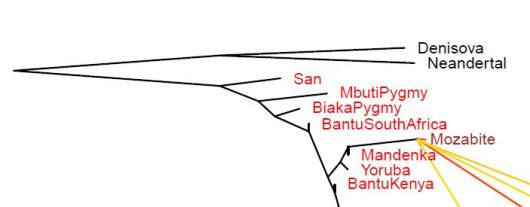The research of the human family tree never stood still but since DNA Research began it is in full motion. Below we use a research (that uses many others) that offers new insights. The last word concerning the human family tree however is still not said and it will probably not be spoken for a very long time.
A new study by Joseph Pickrell and Jonathan K. Pritchard, “Inference of population split from genome-wide allele frequency data and mixtures”, yielded a new family tree of humanity. In fact a new human family tree of which different variants were produced. In this pedigree, account was taken of important migrations that happened after the great spread of humans across the world from Homo heidelbergensis on. We discuss the most important aspects.
When looking at the tree we see that Homo Neanderthalensis and the Denisova hominins (that may be another kind of Neanderthal) first split from this human tree. They descended, like Homo sapiens, from Homo heidelbergensis and migrated from Africa to Eurasia around 800,000 years ago where they split in two branches around 640,000 years ago. These are approximate values which are based on average mutations.
Homo heidelbergensis evolved to Homo sapiens In Africa. On the family tree, we see that the San (or Bushmen) appear at the oldest split of Homo sapiens groups. One study states that this happened maybe between 150,000 and 90,000 years ago.[1]
The next Division was that of Mboeti-Pygmies that live in Northeast Congo.
The third division was that of the Biaka Pygmies that mainly live in the Republic of Congo and the Central African Republic.
These three groups lived until recently as hunters and gatherers. The DNA of these peoples was so long preserved because they lived isolated until recently from recent developments such as the further spread of agriculture in Africa from Cameroon/Nigeria to the East and the South. From the fact that KhoiSan stand at the root of the human family tree we cannot infer that modern humans originated in southern Africa. It just means that very old mutations are found there. If we go back far enough in time all humans have the same ancestors but one branch must have the oldest least changed DNA.
The next group that we see on the human family tree are the Bantus of southern Africa. Their ancestors were the first that departed from Cameroon about 4000 years ago. The forefront retained its DNA. One sees also that the fork of the Bantus in Kenya is more recent. That points to a later departure from the core area in Cameroon/Nigeria.
To the African Branch of the modern humans we also see the Mozabite people. These are Berbers who live in the Algerian Sahara. The article gives no detailed explanation about them but we know that for the related Tuareg female DNA (mtDNA) is for approximately 82% sub-Saharan[2] and male DNA (y-chromosome) only 20%. 18% of Tuareg mtDNA is Berber and 82% of male DNA. The Mozabite people did to slave trade and it was the men who traveled. Mixing with black female slaves was obvious. Arrows connect the Mozabite people with the Middle East, with the spread of agriculture to North Africa and southern Europe.
[1] Doron M. Behar et al., The Dawn of Human Matrilineal Diversity, The American Journal of Human Genetics, 24 April 2008.
[2] Rando (1998), “Mitochondrial DNA analysis of Northwest African populations reveals genetic exchanges with European, Near-Eastern, and sub-Saharan population
